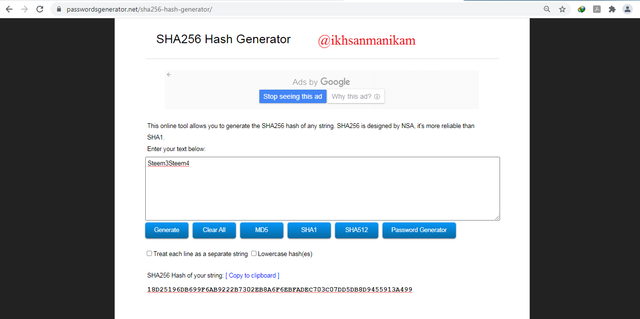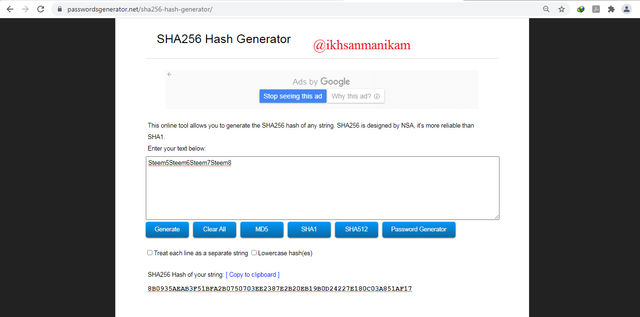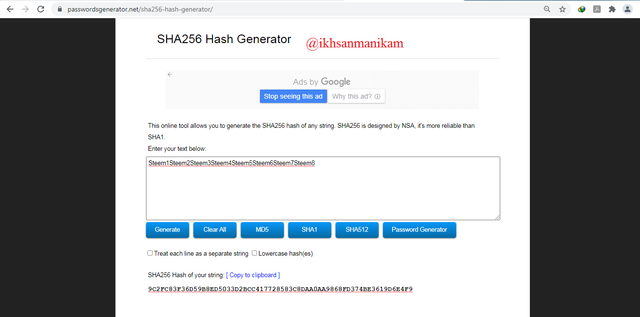
Good night everyone. Tonight I will take a class mentored by professor @pelon53 in the Steemit Crypto Academy community and in this post I will try to complete the homework given by the professor. The topic we will cover in this class is about Root Hash and Merkle Tree. There are three main questions to answer in this homework and let's try to answer them...
Q1.) Explain in Detail The Hash Rate

Hash and Hash rate are terms that we often hear in the cryptocurrency world, especially in cryptocurrency mining activities and in this post we will discuss about Hash rate and how important it is.
In simple terms, Hash rate is a mining speed level that is seen based on the computing power of a device used in mining a cryptocurrency and this speed level is measured on a Hash per Second (H/s) scale. If a device has a Hash rate of 1 Kilo Hash per Second (KH/s) it means that the device can calculate 1 Kilo Hash (1000 Hash) every second. The higher the Hash rate of a device, the faster the mining process is carried out.
Hash rate is very important in the world of cryptocurrency, the ever-growing growth of the blockchain network causes the Hash rate to increase with increasingly difficult mathematical operations. The higher the hash rate, the better the network security. That way, the higher investor confidence in cryptocurrencies. A high hash rate also indicates a lot of resources are devoted exclusively to processing transactions on the blockchain.
With higher network speeds, it becomes increasingly difficult for hackers to obtain the hashing power needed to attack the network. In addition, mining also becomes increasingly difficult as the difficulty level of mathematical puzzles increases. The harder the mining is going on, the more hash the miner needs to get the reward, causing the total hash to be higher.
Q2.) Make The Following Merkle Tree:
Transaction (Tree Leaves): Steem1, Steem2, Steem3, Steem4, Steem5, Steem6, Steem7, Steem8
Made it to The Root Hash and put every Hash Generated using SHA-256, Show Screenshots
Tell The Steps to Follow to Verify if Steem6 is Included in The Markle Tree
Steem1
Hash:
7760E25BCB80ADF1DD92DB339BF5790A59E90CD54EFA072F1250DCE13FA97045

Steem2
Hash:
FE00506E91CF52BC4B35321E6B978D1A7349397B19C6C1C01E095971FDEC9741

Steem3
Hash:
A9418332E0C351D6A50C835AA9E57D514F0573C231D491E97726DB8A5844F2DC

Steem4
Hash:
22F4EC8E20C9CCAF2C313B23F18981B1C73BF39081BCD739E5D998A95A46AB30

Steem5
Hash:
2A3C87336683AB0DDFA56AFEFC740E6C13A02FEA0A43D6797343B26D7AF0C57B

Steem6
Hash:
A7BAA6DE0C0658E9E3681966E542BACD116529F5AE9A2D9126CDB1C1D5BC1278

Steem7
Hash:
D441688DDA7F9285E8811728DD9A3955CF74F0A3C7600C1589D0F1D3B48FFAC7

Steem8
Hash:
F2E38ED4FF662087B6E9BEAFA4158EBC488B995732057BDA019A6A77FFB5F9F5

Steem1Steem2
Hash:
A5568957014F6AC3866923C7DE20D375E706B8D8C9F453636E90B9965ABEC62B

Steem3Steem4
Hash:
18D25196DB699F6AB9222B7302EB8A6F6EBFADEC703C07DD5DB8D9455913A499

Steem5Steem6
Hash:
D118E137F92A0DBEA138B6BF70C7714153A7BC393CD0272A44BD94864645224B

Steem7Steem8
Hash:
A81D57BA11AEDFA9EFBBA42F6523D75D1EFA50B22C5E3557A21CEFFE87DDFC4A

Steem1Steem2Steem3Steem4
Hash:
8A248C05E69C4F1AA403AD18A7F445FF500C42483DA425CE0C980CDB2FD1AD9B

Steem5Steem6Steem7Steem8
Hash:
8B0935AEAB3F51BFA2B0750703EE2387E2B20EB19B0D24227E180C03A851AF17

Steem1Steem2Steem3Steem4Steem5Steem6Steem7Steem8
Hash:
9C2FC83F36D59B8ED5033D2BCC417728583C8DAA0AA9868FD374BE3619D6E4F9


To ensure whether Steem6 is included in the Markle Tree or not, then we only need to download the Root Hash and check it. In simple terms, here are the steps.
- Check Hash Steem5, Steem7Steem8 and Steem1Steem2Steem3Steem4.
- Calculate Hash Steem6.
- Calculate Hash Steem5Steem6.
- Calculate Hash Steem5Steem6Steem7Steem8.
- Calculate Hash Steem1Steem2Steem3Steem4Steem5Steem6Steem7Steem8.
- And it is proven that the last Hash is the Root Hash of the Merkle Tree.
- Means it is true that Steem6 is included in the Markle Tree.
Q3.) Using The SHA-256, You must Place each Complete Hash in The Merkle Tree
Transaction (Tree Leaves): SCA1, SCA2, SCA3, SCA4, SCA5, SCA6, SCA7, SCA8. Explain each Step, Show Screenshots
If The Number of Leaves on The Tree is Odd, What should you do? Explain
SCA1
Hash:
13E0A04BB0E669E1C638DBE3A704743F99F162B25245E4D8C064D35BA38FA8C8

SCA2
Hash:
27849353A9C8CC4E948EB6E5748EDD79CB83513D8C0ADAF3E8C83D3792C9149B

SCA3
Hash:
67E872F952C105C35E0BCE130536D061F4999DCA5593754BA9BA7BE59B8E7C0D

SCA4
Hash:
491928A32BAE70A12FA251412BBFD7C9999F317BA6BF577C283C724225270A43

SCA5
Hash:
99C078C39CDE7F47799E0E8691460A9F3E83E78D498EA989308FCFCC58907B19

SCA6
Hash:
7A648D887B124DB14E96E23BA92783E7F26D00957C19B9B8229632C2C1873729

SCA7
Hash:
7E0BBD6BA4BA9896F9911AF46B06DD2C47535F9C80B29D693FDF6B9319D0D68E

SCA8
Hash:
562ABCEEB497E1FE7AE275A883FD5EF9D92A05F5C19D82ABAA0DC1571B7DF3AD

SCA1SCA2
Hash:
91B09BBA815748166FB36413342C7E4E7E809F4BAC538C0418841A4476B527EF

SCA3SCA4
Hash:
B49B48697A3ACBC5E3D2E36B6EE49C44020D88E664C5C1AA7A7CF34058177379

SCA5SCA6
Hash:
F026924CD1285FF92C2A2DE9B9313027EB67273A82375C939348C887F6B52F77

SCA7SCA8
Hash:
AA55EC5A6B11393B289C4B2B6916172ACC2941C5C978FB1D7BF02696BAB323A4

SCA1SCA2SCA3SCA4
Hash:
F50DC120CBF6C46923037F6D7F41D4153ECC9AB7430DDA662C142DB1FFE483F7

SCA5SCA6SCA7SCA8
Hash:
A3D8CA8494CC426ABD5E1FC5FA0FEAE4F2B2ECE4C4CECDCA05E19EB66542533F

SCA1SCA2SCA3SCA4SCA5SCA6SCA7SCA8
Hash:
CB40CA6DB72DD507CF9118963F94B7740822258E74AFB0FD45D89DB35D24B386


Leaves on Merkle Tree is designed in a pairwise arrangement until it produces only one Root Hash and it will only work if all of them have been met. In this case, the odd leaves will be duplicated and will become an identical pair so that the arrangement of the leaves on the Merkle Tree is even. For more details, let's look at the following pictures.
Sample Case
The following is an illustration showing that the number of leaves on a Merkle Tree is odd. Markle Tree only consists of 7 leaves, namely SCA1, SCA2, SCA3, SCA4, SCA5, SCA6, and SCA7.

Duplicating SCA7
The following is an illustration showing that SCA7 is duplicated into an identical pair so that the arrangement of the leaves on the Merkle Tree is even.

Now we just need to follow the steps as in question number 2 to generate a Root Hash because the arrangement of the leaves on the Merkle Tree is even.
SCA7SCA7
Hash:
71AF5095F10844EDA37CFCF8EE7712ADD5940F4ADAE1946CE66793270438C39B

SCA5SCA6SCA7SCA7
Hash:
2DAE9A09ABB66E133AEBD3F875490C194CD75E035B3AC6D1479379E89CFB2E67

SCA1SCA2SCA3SCA4SCA5SCA6SCA7SCA7
Hash:
79A243A66E564ABAFEADAAA763B0D5BA7CFFD5462ADDC77D88CA683210AA2784
And finally we get the Root Hash.

Merkle Tree Successfull Completed

In addition, here are two different schemes, namely seven-leaf and five-leaf. Both are also solved by the same mechanism, duplication. Here is the simple Merkle Tree flow.
- Illustration of a Merkle Tree with seven leaves, namely SCA1, SCA2, SCA3, SCA4, SCA5, SCA6, and SCA7.

- Illustration of a Merkle Tree with five leaves, namely SCA1, SCA2, SCA3, SCA4, SCA5.

Crypto mining is closely related to solving difficult and complex mathematical puzzles that require devices that have high computing power and high speed. The higher the Hash rate, the faster the processing that occurs. The higher the speed of a device, the more energy it uses.
Merkle Tree also plays an important role here, especially in managing transaction details. With Merkle Tree we also do not need to verify all transactions in a block to access a particular transaction details. Root Hash is the last Hash contained in a Merkle Tree and this Hash contains all the details of previous transactions.